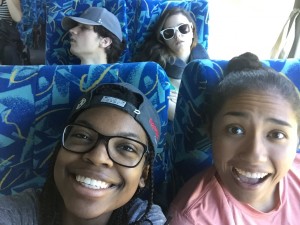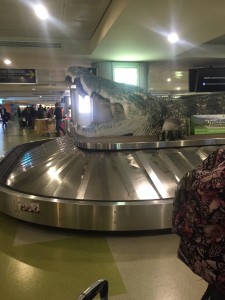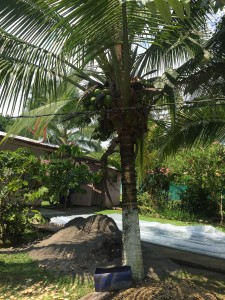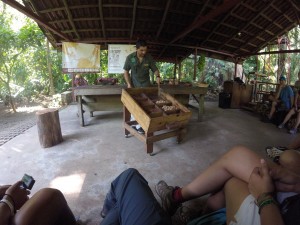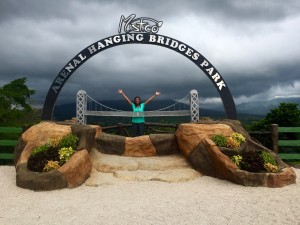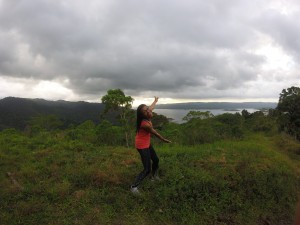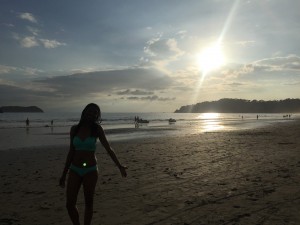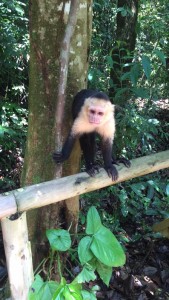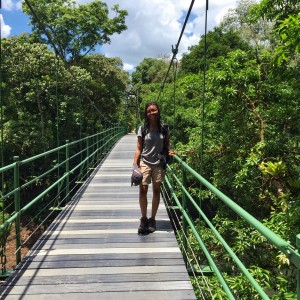The night before heading to Costa Rica, I was nervous. Nervous to travel to a different country without my parents, even thought I had done it before. Nervous to see what Costa Rica had to offer. Learning about it in class was great but actually going to see what we had learned was fantastic. I brought my journal with me so that I could write down the thoughts that I had while I was there. The journal representing my blank book, or THE blank book. The book that writes the future of my life, of our life, of the planets life. Mother Nature’s future from the perspective on a small girl, me. We can start with day 1.
Day 1: Honestly, 2:30am is way too early to be waking up to go to the airport. I am excited though so I guess it is okay. Good bye traffic! Good bye concrete everything! Good bye people in bad moods! I’M GOING TO COSTA RICA! We get checked in and board the plane, everything is great. Oh wait, never mind. The weather in Houston is being bipolar, as usual, so we can not leave yet. Perfect. After getting off of the plane, waiting for a couple of hours, and getting mixed information from the airport staff, we finally board the plane and are off to Houston. Through all of that, we missed are flight to Costa Rica
and had to spend the rest of the day in the Houston airport. 10+ hours pass and a lot of bonding time later, we are finally off to Costa Rica! The first thing I noticed when on the way to get my luggage was the advertisement of animals on the walls once you start walking through the airport. The giant crocodile that basically regurgitates people’s luggage at baggage claim was the icing on the cake. Seeing that confirmed my internal theory that they cared about their animals and wanted to show all of their visitors that Costa Rica was one of the most biodiverse place on the planet. The humidity hit me once I exited the airport. Being born and raised in Houston, I would think that I would be used to humidity but this was a whole different kind of humidity. The discovery of no air condition at Earth University surprised me a bit but it was fine once the fan was on. The balcony of my room faced the forest and I could hear all sorts of different animal sounds coming from the trees. There were tons of insects crawling around that I had never seen before and I even saw an armadillo playing in the grass on the edge of the forest. That’s the kind of thing that wouldn’t be seen in Austin.
Day 2: Today we woke up early and helped build a greenhouse for a family. This included putting the actual structure up, replacing plastic jugs that they reused to create borders for the garden beds, and mixing
organic fertilizer that was used in the garden. Throughout our time at the families farm I noticed that they had a house just big enough for what they needed and an array of different trees and plants on their land. The beautiful thing is that what I saw with my eyes, was not even half of the trees and plants that was present on the farm and the farm itself, though not very wide, stretched further that I could see. I would bet that the biodiversity that was present on that farm is far greater than the biodiversity found on campus at St. Ed’s. When we went back to Earth University, we took a tour of some of the student’s projects in their garden. It is amazing how many different kinds of crops can increase oxygen production and decrease carbon dioxide levels in a minimal amount of space. If everyone around the globe had one of these or another form of space saving minimal gardens, it would being so much life to places with minimal life and maybe even increase plant diversity among parts of the
planet that lack it. Creating more accommodations for carbon storage. Tonight, I got lost going back to my room from dinner, I was a little scared because there were no bright lights around the campus for me to see long range where I was going but after panicking for a bit, I slowed my pace, looked around, and listened to my surroundings. Earth University was literally placed into the forest with minimal technology, only the basics needed to run a sustainable institution. They do not need air conditioned class rooms, they do not need bright lights to light up the university. That would take away the whole point of being sustainable and would eventually disrupt the nature surrounding it. Probably driving away the animals that make up the surrounding environment.
Day 3: We’ll come back to day 3.
Day 4: Our stay in La Tirimbina was short lived but interesting. The bridge to the forest was extremely long and pretty scary. The hike up to the chocolate tour was not that bad and the chocolate tour itself was fantastic! History, laughing, and hands-on learning are the best ways to embrace education. While reading
up on cacao and Costa Rica, I found something interesting. “…although cacao plantations cannot substitute for forest, they provide habitat for a large number of species…” (Reitsma). I was thinking that that might be another reason that cacao was so relevant in Costa Rica, besides the human spread of the tree, animals were using it as a habitat as well. Using the cacao itself as a food source. I learned so much and the chocolate was so good!! I probably had about five samples and it does not help that chocolate is one of my favorite things to eat. Definitely regret it on the bus ride though. Eating lots of pure chocolate then getting on a bus to go through
winding roads through the mountains with intense slopes equals no bueno. I have never been so sick in my life. I thought I was dying. Once we got to the hanging bridges, I felt a little better and being up close with the rainforest made me feel so happy. It was so dense and there were so many different organisms living in harmony it felt magical. The night hike was even more fantastic. One of the best parts was learning that they had a tree nursery of native trees that were to be planted to redevelop land that needed help. I also found out that if companies destroy land and are caught, one of their fines is to replant the land with native trees and plants to encourage the forest and biodiversity to come back. That is a good thing to do besides having the perpetrator just pay a fine… let them put back what they destroyed. I think that should be done in the United States as well as all over the world. It would increase the amount of trees and carbon storage possibilities that were depleted from previous years.
Day 5: Ziplining in La Fortuna was one of the scariest things that I have ever done in my entire life. I am afraid of rapid declines and I do not know how I did this. I am glad that I did though. Seeing the rainforest from the canopy and emergent trees changed my perception of life. My mind was so clear and the view was inspiring. I am probably never going to do that again, but it will forever be engraved in my brain.
Everyone in the world should experience this at least once. It would create a positive vibe about the environment for so many people. Next was Rancho Margot, it blew my mind that it was off the grid. It was a large place and for them to be completely sustainable was very impressive. There was so much of the environment surrounding me and I think that was the only time out of the entire trip where I felt like I was sleeping outside and one with nature for the entire time that I was there. I road a horse named Chapilan to the top of one of the mountains that had an amazing view also rode that horse while it was running in the rain. I could feel my spirit becoming one with the rainforest. I would hate to use the word magical again but it was magical, maybe beyond magical. I had never been around so many trees before and while writing this blog days later, I am still lost for words.
Day 6-7: The beach was beautiful and surrounded by mountains with large dense trees. Not once did I see
trash on the beach. Everything was clean and the sand and water were even more white and crystal blue inside of the Manuel Antonio National park. I wanted to know some numbers so I found out that “The principal habitants are primary forest, secondary forest, mangrove swamps, lagoons and beach vegetation. There is quite a varied fauna with 109 species of mammals and 184 of birds. The park includes 12 little isles just off the coast; these often visited by a number of dolphins and, at times, migrating whales…” (Manuel Antonio Park).
The only thing worries me is the capuchin monkeys interacting so close to the visitors of the park. The “gate security” could have done a better job of limiting what people brought into the park but the I think they did a good job of keeping people on the path that they were supposed to stay on and not disrupting the wildlife as much. The park itself was pretty small and there was a lot of hustle and bustle outside of the gates and less greenery than it looked like it should have been.
Day 8: Home!
Day 3: The visit to the Biological Station in La Selva was probably the best part of the entire trip for me. It might have been because it activated the science nerd inside of me. It honestly made me question my career choice. Do I really want to go to Vet school and open my own practice or do I want to become an environmental biologist and live in La Selva for the rest of my life?! My internal nerd was freaking out over the entire informational lecture, taking everything in. I did some searching online and found that “La Selva was originally established in 1954 by Dr. Leslie Holdridge, as a farm dedicated to experimentation on mixed plantations for the improvement of natural resources management. It was purchased in 1968 by the Organization for Tropical Studies and declared a private biological reserve and station. Since then, it has become one of the most important sites in the world for research on tropical rain forest. Over 240 scientific papers are published yearly from research conducted at the site” (Organization for Tropical Studies). Due to research done at the Biological Station, science now knows that there is a decreasing correlation between tree growth and temperature (between 20 degrees Celsius and 22 degrees Celsius) and an increasing correlation between tree growth and rainfall. It blew my mind when I heard that there is a big decline in tree growth when there is only a two degree Celsius difference. If that can happen in the rainforest in Costa Rica, it can definitely happen anywhere and everywhere else in the world.
Two degrees may not seem like a lot but the more carbon emissions there are, the more the Earth warms up. The more the Earth warms up, the smaller the trees grow, the less carbon they store, and more species are lost due to habitat destruction. This gives way to more space for humans to build houses, drive vehicles, or create previous forests into farmland which will probably increase levels of atmospheric methane, which will then in turn increase the planet’s overall temperature even more. The temperature can only go so high until the photosynthetic carbon uptake by plants can no longer offset the carbon emission by plants and other entities. Once that threshold is reached, there is very little we can do to turn it around. We are basically screwed and the even sadder part of all of this is that we have almost reached that threshold. That is exactly what the COP21 talks in Paris in 2015 were about…to address the threshold. Officially “In 2015 COP21, also known as the 2015 Paris Climate Conference, will, for the first time in over 20 years of UN negotiations, aim to achieve a legally binding and universal agreement on climate, with the aim of keeping global warming below 2°C”(Climate Action and UNEP). Among other things such as zero greenhouse gas emissions during the second half of the 21st century and things like that. The world has high hopes and thinks that this is doable but in my opinion, I do not think that we are going to make that goal in the amount of years that we think we are. During the lecture at La Selva, I was writing things down like crazy. A few things that really stuck with me was the idea that “science is a life story”, as said by Carlos the man who was talking to us. I believe that that was his name. He mentioned something along the lines of science being a way to tell a story of how something died or of how something is living and interacting with it’s environment. It is like someone following you, for example, around and writing everything down. Trying to piece together how you fit in life’s complicated puzzle. I like to think of it as putting together a puzzle that you do not know what it looks like or how many pieces it contains. There was something else that Carlos said during our lecturing time together. This is not word for word but it is close, “destroying forests is like taking books from a library that have not been catalogued yet, or even opened. They have no title and you do not know what is in them, and just throwing them away. Those books could have had the cure for cancer in them but they were not even looked at. Now they are gone. You can not get that information back. Once it is gone, it is lost forever. Science is personal. It can cure the world. Unexplored forests can cure the world”(La Selva Biological Station, Carlos). That was very powerful to me and it summed up my entire trip to Costa Rica and sparked an even larger appreciation for trees, the carbon they store, the diversity among the various plants and animals, and the endless, unexplored possibilities of the environment. This blog went from addressing climate change and carbon storage to a greater found appreciation for the unexplored forest and the many undiscovered puzzle pieces and open books that need to be saved and distributed to the world. Mother Nature is essentially a library and people are damaging the books. If we can not stop them, we need to read all of the books before they are destroyed beyond repair and are lost forever.
Works Cited:
Climate Action, and UNEP. “COP21 Paris,France.” COP21Paris. N.p., 2015. Web. 21
May 2016. <http://www.cop21paris.org/about/cop21/>.
La Selva Biological Station, Carlos. Personal interview. 11 May 2016.
Manuel Antonio Park. “Manuel Antonio Park.” Manuel Antonio Park. N.p., n.d. Web.
23 May 2016. <http://manuelantoniopark.com>.
Organization for Tropical Studies. “History.” Organization for Tropical Studies.
N.p., 2015. Web. 22 May 2016. <http://www.tropicalstudies.org/
index.php?option=com_content&task=view&id=162&Itemid=348>.
Reitsma, R., J. D. Parrish, and W. McLarney. “The role of cacao plantations in
maintaining forest avian diversity in southeastern Costa Rica.”
Agroforestry Systems 53.2 (2001): 185-93. Print.
